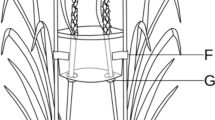Abstract
Attraction and pheromonal activity of five major identified components of the male-produced sex pheromone of the Mediterranean fruit flyCeratitis capitata to virgin laboratory-reared females was assessed in a laboratory flight tunnel. Dual-choice competitive assays were run to establish a baseline response of virgin females to live male pheromone, individual components, and an ensemble of all five compounds alone (air control) and competitively against one another. Approximately 50% of the females released in the tunnel were captured on leaf models emitting pheromonal odors from five live males. Over 37% of released females responded to an ensemble of five major identified components presented in individual capillaries. Response of females to individual components was less than 10%. Competitive assays showed the live male-produced pheromone to be more attractive than either the five major component ensemble (FMCE) or individual components. Further research is likely to identify other male-produced compounds with pheromonal activity that could improve development of a pheromone-based trap for monitoring Mediterranean fruit fly populations.
Similar content being viewed by others
References
Baker, R., Herbert, R.H., andGrant, G.G. 1985. Isolation and identification of the sex pheromone of the Mediterranean fruit fly,Ceratitis capitata (Wied.),J. Chem. Soc. Chem. Commun. 1985:824–825.
Baker, P.S., Howse, P.E., Ondarza, R.N., andReyes, J. 1990. Field trials of synthetic sex pheromone components of the male Mediterranean fruit fly (Diptera: Tephritidae) in southern Mexico.J. Econ. Entomol. 83:2235–2245.
Beroza, M., Green, N., Gertler, S.I., Steiner, L.F., andMiyashita, D.H. 1961. New attractants for the Mediterranean fruit fly.J. Agric. Food Chem. 9:361–365.
Cunningham, R.T. 1966. Sex identification of pupae of three species of fruit flies (Diptera: Tephritidae).Ann. Entomol. Soc. Am. 59:864–865.
Feron, M.M. 1959. Attraction chimique du male deCertitis capitata Wied. (Diptera: Trypetidae) pour la femelle.C.R. Acad. Sci., Paris. Ser. D. 248:2403–2404.
Feron, M.M. 1962. L'instinct de reproduction chez la mouche Mediterraneane de fruitsCeratitis capitata Wied. (Diptera: Trypetidae). Comportement sexuel-comportement de ponte.Rev. Pathol. Veg. Entomol. Agric. Fr. 41:1–129.
Flath, R.A., Jang, E.B., Light, D.M., Mon, R.T., Carvalho, L., Binder, R.G., andJohn, J.O. 1993. Volatile pheromonal emissions from the Mediterranean fruit fly: Effects of fly age and time of day.J. Agric. Food Chem. 41:830–837.
Gertler, S.I., Steiner, L.F., Mitchell, W.C., andBarthel, W.F. 1958. Esters of 6-methyl-3-cyclohexane-1-carboxylic acid as attractants for the Mediterranean fruit fly.J. Agric. Food Chem. 6:592–594.
Gow, P.L. 1954. Proteinaceous bait for oriental fruit fly.J. Econ. Entomol. 47:61–66.
Heath, R.R., Landolt, P.J., Tumlinson, J.H., Chambers, D.L., Murphy, R.E., Doolittle, R.E., Dueben, B.D., Sivinski, J., andCalkins, C.O. 1991. Analysis, synthesis, formulation and field testing of three major components of male Mediterranean fruit fly pheromone.J. Chem. Ecol. 17:1925–1940.
Jacobson, M., Ohinata, K., Chambers, D.L., Jones, W.A., andFujimoto, M.S. 1973. Insect sex attractants: 13. Isolation, identification and synthesis of sex pheromones of the Mediterranean fruit fly.J. Med. Chem. 16:248–251.
Jang, E.B., andLight, D.M. 1991. Behavioral responses of female oriental fruit flies to the odor of papayas at three different ripeness stages in a laboratory flight tunnel (Diptera: Tephritidae).J. Insect Behav. 4:751–762.
Jang, E.B., Light, D.M., Flath, R.A., Nagata, J.T., andMon, T.R. 1989. Electroantennogram responses of the Mediterranean fruit fly,Ceratitis capitata to identified volatile constituents from calling males.Entomol. Exp. Appl. 50:7–19.
Landolt, P.J., Heath, R.R., andChambers, D.L. 1992. Oriented flight responses of female Mediterranean fruit flies to calling males, odor of calling males, and a synthetic pheromone blend.Entomol. Exp. Appl. 65:259–266.
Linstead, R.P., Noble, E.G., andBoorman, E.J. 1933. Investigations of the olefinic acids. Part VI. The preparation of ΔB-acids.J. Chem. Soc. 1933:557–561.
McPhail, M. 1939. Protein lures for fruit flies.J. Econ. Entomol. 32:758–761.
Nakagawa, S., Steiner, L.F., andFarias, G.J. 1981. Response of virgin female Mediterranean fruit flies to live mature normal males, sterile males and trimedlure in plastic traps.J. Econ. Entomol. 74:566–567.
Ohinata, K., Fujimoto, M.S., Chambers, D.L., Jacobson, M., andKamakahi, D.C. 1973. Mediterranean fruit fly: Bioassay techniques for investigating sex pheromones.J. Econ. Entomol. 66:812–814.
Ohinata, K., Jacobson, M., Nakagawa, S., Fujimoto, M.S., andHiga, H. 1977. Mediterranean fruit fly: Laboratory and field evaluations of synthetic sex pheromones.J. Environ. Sci. Heath A12:67–78.
Sakamoto, S., andSamejima, K. 1979. Determination of 1-pyrroline as 2,3-trimethylene-4-quinazolone.Chem. Pharm. Bull. 27:2220–2222.
SASInstitute. 1988. SAS/STAT User's Guide. Release 6.03 edition. SAS Institute, Cary, North Carolina.
Steiner, L.F. 1952. Fruit fly control in Hawaii with poison-bait sprays containing protein hydrolysates.J. Econ. Entomol. 45:838–843.
Weatherston, I., Miller, D., andDohse, L. 1985. Capillaries as controlled release devices for insect pheromones and other volatile substances—a reevaluation: Part 1. Kinetics and development of predictive models for glass capillaries.J. Chem. Ecol. 11:953–965.
Author information
Authors and Affiliations
Rights and permissions
About this article
Cite this article
Jang, E.B., Light, D.M., Binder, R.G. et al. Attraction of female mediterranean fruit flies to the five major components of male-produced pheromone in a laboratory flight tunnel. J Chem Ecol 20, 9–20 (1994). https://doi.org/10.1007/BF02065987
Received:
Accepted:
Issue Date:
DOI: https://doi.org/10.1007/BF02065987




